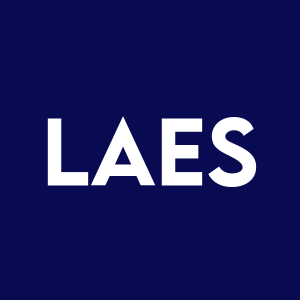SEALSQ Quantum-Resistant Technology Tackles Potential Bitcoin’s Quantum Vulnerabilities
Rhea-AI Summary
SEALSQ Corp (NASDAQ: LAES) announced its development of solutions to address quantum computing challenges through its QUASARS project, focusing on Post-Quantum Cryptography (PQC) and quantum-resistant hardware for IoT and blockchain networks. The company highlighted Bitcoin's vulnerabilities to quantum computing, particularly in p2pk and reused p2pkh addresses. Current scientific estimates indicate it takes approximately 30 minutes for a quantum computer to hack a Bitcoin signature, compared to Bitcoin's 10-minute block mining time.
The company outlined potential mitigation strategies, including transferring funds to new p2pkh addresses and implementing consensus-driven ultimatums for moving funds to safe addresses. SEALSQ is developing quantum-resistant cryptographic solutions to ensure blockchain and IoT networks remain secure in the quantum computing era.
Positive
- Leading development of quantum-resistant technology for blockchain and IoT security
- Strategic positioning in emerging post-quantum cryptography market
- Current Bitcoin network remains secure against existing quantum computing capabilities
Negative
- Identified critical vulnerabilities in Bitcoin's cryptographic security
- Growing quantum computing threat to blockchain security
- Implementation of solutions requires broad consensus and complex coordination
News Market Reaction 1 Alert
On the day this news was published, LAES gained 78.18%, reflecting a significant positive market reaction.
Data tracked by StockTitan Argus on the day of publication.
Geneva, Switzerland , Dec. 23, 2024 (GLOBE NEWSWIRE) --
SEALSQ Corp (NASDAQ: LAES) ("SEALSQ" or "Company"), a company that focuses on developing and selling Semiconductors, PKI, and Post-Quantum technology hardware and software products, today announced that it is at the forefront of developing innovative solutions to address the challenges posed by quantum computing. Through its QUASARS project, SEALSQ is advancing the field of Post-Quantum Cryptography (PQC) by creating hybrid solutions and quantum-resistant hardware designed to secure critical systems such as the Internet of Things (IoT) and blockchain networks.
Quantum Computing Risks to Bitcoin
As quantum computing evolves, its potential to disrupt blockchain-based systems like Bitcoin is becoming more evident. Bitcoin’s security relies on cryptographic principles that could be compromised by sufficiently powerful quantum computers.
Key vulnerabilities include:
- p2pk and Reused p2pkh Addresses: These expose public keys, allowing quantum computers to derive private keys and steal funds.
- Unspendable Bitcoins: Many Bitcoins in vulnerable addresses are inaccessible because their private keys have been lost. Without action, these coins remain at risk once quantum computers achieve sufficient computational power.
Mitigating Bitcoin’s Quantum Vulnerabilities
To safeguard Bitcoin against quantum threats, the community can take several actions:
- Transfer Funds to New p2pkh Addresses: Bitcoins in unused p2pkh addresses remain quantum-safe because their public keys are not exposed. Transferring funds to such addresses can prevent immediate risks.
- Consensus-Driven Ultimatums: A potential solution is for the Bitcoin community to establish an ultimatum requiring funds to be moved to safe addresses. After a set period, coins in unsafe addresses could become unusable. This measure, while effective, requires broad consensus and careful implementation to avoid unintended consequences.
Long-Term Resilience of Bitcoin
Even if all vulnerable Bitcoins are secured, blockchain systems remain at risk during transactions:
- Public keys are revealed when funds are transferred, creating a window for attackers with quantum computers to derive private keys and initiate competing transactions.
- Currently, Bitcoin’s network requires about 10 minutes to mine a block. Quantum computers would need to derive private keys faster than this to exploit the system. Scientific estimates suggest it currently takes a quantum computer approximately 30 minutes to hack a Bitcoin signature, making Bitcoin resistant for now. However, rapid advancements in quantum technology could reduce this time, jeopardizing the blockchain’s inherent security.
SEALSQ’s Commitment to a Quantum-Secure Future
SEALSQ is proactively addressing these challenges by developing quantum-resistant cryptographic solutions. Its innovations in hybrid post-quantum hardware and software ensure that critical systems, including Bitcoin and IoT networks, remain resilient in the quantum era. SEALSQ’s efforts empower organizations to transition securely into a future where quantum computing is a reality.
With its cutting-edge technology and dedication to cybersecurity, SEALSQ continues to lead the way in building a secure digital future that is resistant to even the most advanced threats.
About SEALSQ
SEALSQ is a leading innovator in Post-Quantum Technology hardware and software solutions. Our technology seamlessly integrates Semiconductors, PKI (Public Key Infrastructure), and Provisioning Services, with a strategic emphasis on developing state-of-the-art Quantum Resistant Cryptography and Semiconductors designed to address the urgent security challenges posed by quantum computing. As quantum computers advance, traditional cryptographic methods like RSA and Elliptic Curve Cryptography (ECC) are increasingly vulnerable.
SEALSQ is pioneering the development of Post-Quantum Semiconductors that provide robust, future-proof protection for sensitive data across a wide range of applications, including Multi-Factor Authentication tokens, Smart Energy, Medical and Healthcare Systems, Defense, IT Network Infrastructure, Automotive, and Industrial Automation and Control Systems. By embedding Post-Quantum Cryptography into our semiconductor solutions, SEALSQ ensures that organizations stay protected against quantum threats. Our products are engineered to safeguard critical systems, enhancing resilience and security across diverse industries.
For more information on our Post-Quantum Semiconductors and security solutions, please visit www.sealsq.com.
Forward Looking Statements
This communication expressly or implicitly contains certain forward-looking statements concerning SEALSQ Corp and its businesses. Forward-looking statements include statements regarding our business strategy, financial performance, results of operations, market data, events or developments that we expect or anticipates will occur in the future, as well as any other statements which are not historical facts. Although we believe that the expectations reflected in such forward-looking statements are reasonable, no assurance can be given that such expectations will prove to have been correct. These statements involve known and unknown risks and are based upon a number of assumptions and estimates which are inherently subject to significant uncertainties and contingencies, many of which are beyond our control. Actual results may differ materially from those expressed or implied by such forward-looking statements. Important factors that, in our view, could cause actual results to differ materially from those discussed in the forward-looking statements include SEALSQ’s ability to implement its growth strategies; SEALSQ’s ability to successfully launch post-quantum semiconductor technology; SEALSQ’s ability to capture a share of the quantum semiconductor market; the growth of the quantum computing market; SEALSQ’s ability to expand its U.S. operations; SEALSQ’s ability to make additional investments towards the development of a new generation of quantum-ready semiconductors; SEALSQ’s ability to continue beneficial transactions with material parties, including a limited number of significant customers; market demand and semiconductor industry conditions; the growth of the quantum computing market; and the risks discussed in SEALSQ’s filings with the SEC. Risks and uncertainties are further described in reports filed by SEALSQ with the SEC.
SEALSQ Corp is providing this communication as of this date and does not undertake to update any forward-looking statements contained herein as a result of new information, future events or otherwise.
| SEALSQ Corp. Carlos Moreira Chairman & CEO Tel: +41 22 594 3000 info@sealsq.com | SEALSQ Investor Relations (US) The Equity Group Inc. Lena Cati Tel: +1 212 836-9611 / lcati@equityny.com Katie Murphy Tel: +212 836-9612 / kmurphy@equityny.com |







